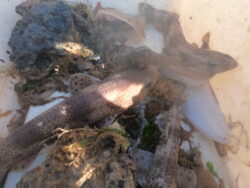The Thames River has come a long way since being declared as “biologically dead” in 1957, caused by severe pollution and exploitation. Through considerable effort by policy makers and environmental organisations the Thames is said to be on the road to recovery, observed through improved water quality and increased biodiversity. At present the Thames estuary is believed to support 115 species of fish (Environment Agency) and 92 species of birds (British Trust for Ornithology), in addition to the highly diverse community of invertebrates that can be found in the benthos.
The presence of sharks within the estuary has often taken the public by surprise. A few species of shark have been recorded by Eco Marine field staff when conducting surveys in the Thames estuary, including the starry smooth hound (Mustelus asterias) and small-spotted catshark (Scyliorhinus canicula). However, other species are known to be present, such as the common smooth hound (Mustelus mustelus), tope shark (Galeorhinus galeus), and spurdog shark (Squalus acanthias). Some key facts about these species include:
- Starry smooth hounds can grow up to a length of 140cm, are mostly grey with a white underside, and are covered in small white spots along their back, hence the name ‘starry’.
- Small spotted catsharks are a smaller species, reaching only 75cm in length, and have a range of contrasting common names including dogfish, rough hound, and rock salmon.
- Spurdog sharks made headlines back in 2021 being referred to as ‘the venomous shark patrolling the waters in London’ due to the spines on the front of their dorsal fin through which venom is secreted to subdue prey.
- Tope sharks are also widely known as the soupfin shark due to their popularity commercially for ‘liver oil’ and fins.
Research has led to the discovery that many of shark species utilise the estuary as a breeding ground and nursery habitat for their young, for example it is thought that spurdog pups live in the Thames estuary for up to two years before leaving for deeper water. The importance of the habitat to these species reproductive success is especially import considering the tope shark is classified as critically endangered by the IUCN red list of threatened species, while the common smooth hound is recorded as endangered and starry smooth hound as near threatened. Along with being classified as critically endangered, the tope shark is also a Priority Species under the UK Post-2010 Biodiversity Framework.
Despite this positive outlook on the health of the Thames River and estuary, work is continually being done to ensure and improve the estuary. Further research is required to better understand the importance of the estuary to these species and to ensure the best chances of their long-term survival in this habitat.
